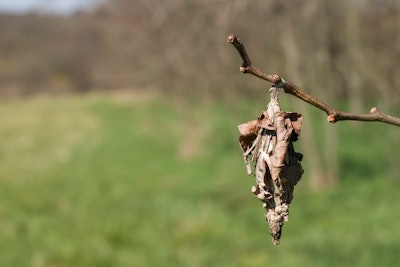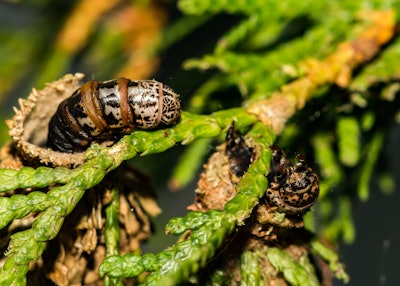
Your clients’ trees and shrubs are some of their landscape’s most valuable assets. They provide aesthetic appeal, privacy, shade, and maybe even sentimental value. The last thing that you want is for your clients to lose a tree or shrub due to a bagworm infestation.
Unfortunately, bagworms can be quite destructive. It’s important that you know the warning signs that this pest is lurking.
Joshua Malik, owner of Joshua Tree Experts, with locations in the Allentown and Lansdale, Pennsylvania areas, says that having a better understanding of this pest can help you protect your clients’ landscape from its damage.
Understanding the bagworm
 Adult bagworms will feed on the foliage of trees and shrubs.
Adult bagworms will feed on the foliage of trees and shrubs.
Bagworms are a type of caterpillar and are characterized by the “bag” that they form to shelter from weather and predators. This bag is actually constructed from silk and pieces of plant foliage. According to Malik, these bags can be as large as two inches so they may be spotted hanging from your client’s tree or shrub branches.
It’s important that you not confuse bagworms with webworms, even though your clients may have heard of both pests and use these terms interchangeably. These pests are quite different and require different controls.
While webworms do form protective nests (“webs”), they appear later in the season—toward the end of the summer even into the early fall. Webworms are also much more conspicuous as their webs can cover the entire foliage and other plant material. Bagworms are a problem in the early summer—typically between June and July.
Spotting bagworm damage
There are a couple of different ways that bagworms can cause damage, depending upon what stage of their lifecycle they’re in.
“Young bagworms can leave small holes in the foliage after feeding,” Malik explains. “But mature bagworms are much more destructive. They will strip evergreens of their needles and even devour entire leaves, only leaving behind the veins. With how aggressive this pest can be, an infestation can mean plants may be destroyed in a matter of weeks.”
It’s not uncommon for clients to see a plant turning brown before they actually see the chewed foliage. As a landscape professional, you can do your clients a big favor by keeping a close eye on their trees and shrubs. Certain species are more prone to bagworm problems than others.
According to Malik, bagworms seem to prefer evergreen species like Juniper, Pine, and Spruce. They’ve also been known to attack certain deciduous trees including the Black Locust, Honey Locust, Willow, and Sycamore. If your clients have any of these plants on their properties, it’s worth some extra attention during bagworm season.
Implementing bagworm control
If your client does not have a total infestation, then bagworms can be hand-picked and removed before hatching. However, if bagworms are too numerous to take care of by hand, Malik says that control products can be used.
“It’s important to ensure the product is professionally applied while bagworms are still actively feeding,” Malik says. “One of the biggest mistakes that we see made is applying product either too early or too late.”
Malik says that control must start when the bagworm is young. When they aren't noticed until the adult stage, they have already done a good bit of damage.
Malik says that preventative bagworm products can also be applied if clients have host plants on their property—or if they have dealt with a bagworm problem in the past. Because these pests can be so destructive to the landscape, it’s important that they’re spotted early—or prevented entirely.






